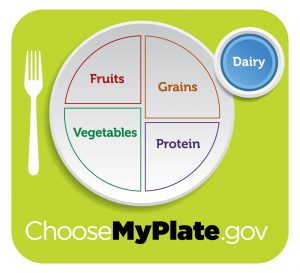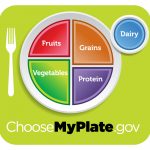Bulletin #4390, Eating for Health with MyPlate: Dairy Foods
 Prepared by Extension Educator Kate Yerxa and Extension Specialist Leslie Forstadt, University of Maine Cooperative Extension. Reviewed by Extension Educator Alan Majka, University of Maine Cooperative Extension.
Prepared by Extension Educator Kate Yerxa and Extension Specialist Leslie Forstadt, University of Maine Cooperative Extension. Reviewed by Extension Educator Alan Majka, University of Maine Cooperative Extension.
For information about UMaine Extension programs and resources, visit extension.umaine.edu.
Find more of our publications and books at extension.umaine.edu/publications/.
Like most Americans, Mainers eat too much fat, sugar, sodium, and refined grains. These Eating for Health with MyPlate fact sheets can start you down the path to good health. Each one is about a different part of the 2020-2025 Dietary Guidelines for Americans and MyPlate healthy eating guidelines. You can learn what each part is, why it’s important, and how it matters to you and to your family. The MyPlate food groups are Grains, Vegetables, Fruits, Dairy, and Protein. This fact sheet explains the Dairy Group.
Which foods are in the Dairy Group?
Fluid milk products, and many foods made from milk, are part of this food group. Common foods in the Dairy Group are milk, yogurt, and cheese. These foods are good sources of calcium. Calcium-fortified drinks like soy milk are also considered part of the Dairy Group.
Foods that are made from milk but contain little or no calcium are not considered part of this food group. Examples of these foods include butter and cream cheese.
How much of this food group should adults eat?
Adult men and women need enough dairy foods to equal 3 cups of milk a day. Choose low-fat or fat-free food choices from the Dairy Group to reduce the amount of saturated fat in your diet. The following count as 1 cup of milk from the Dairy Group:
- 1 cup of milk
- 1 cup (8 ounces) of yogurt
- 1 1/2 ounces of natural cheese (like cheddar, mozzarella, Swiss, or Parmesan)
- 1/3 cup shredded cheese
- 2 ounces processed cheese (like American)
- 2 cups cottage cheese
- 1 cup of calcium-fortified soymilk
Why dairy?
Calcium is a key nutrient found in Dairy Group foods. Calcium builds bones and teeth. It keeps growing bones strong. The vitamin D in some milk foods helps your body use calcium better, so your bones stay strong. Dairy foods also have potassium, which may help lower your blood pressure.
Choose low-fat and non-fat dairy foods. This helps you eat fewer unhealthy saturated fats.
Tips to eat more dairy
Three cups of milk per day can seem like a lot. Try these tips for eating more dairy foods:
- Drink fat-free or low-fat (1%) milk at meals.
- A low-fat yogurt and a piece of fruit make a quick, easy snack.
- Make fruit and yogurt smoothies for breakfast. They make great snacks, too.
- Make casseroles like macaroni and cheese. Use low-fat milk and low-fat cheese.
Dairy foods are the best way to meet your calcium needs. Foods such as leafy greens and broccoli have calcium. But ounce for ounce and cup for cup, they have much less calcium than dairy foods. You would need more than 7 cups of raw broccoli to get the calcium in one cup of milk.
Some people can’t have dairy products: the lactose in dairy foods makes them sick. This is called lactose-intolerance. If you are lactose-intolerant, choose lactose-free dairy foods to help you get enough calcium. You can also try using a lactase enzyme supplement before having dairy foods.
Kids and dairy foods
- The American Academy of Pediatrics recommends that children drink whole milk until age 2. A child who is breast-fed until age 1 may then have whole milk until age 2. After that you can switch to low-fat (1%) or fat-free milk. Whole milk has much more unhealthy fat than low-fat (1%) or fat-free milk.
- Make dairy snacks with fruit! Mix frozen or fresh fruit, fat-free milk, and ice cubes in a blender for a simple smoothie. Or mix low-fat yogurt with fresh fruit for a healthy snack or desert.
- Make cheese and cracker stacks. Cut thin slices of cheese. Ask your child to make little stacks, with one slice of cheese on each cracker. You can also add vegetables like red pepper or tomato.
- Look for low-fat cheeses, yogurt, and milk at the store. These have just as much protein and nutrition as whole-fat cheeses, yogurt, and milk. But they are better for you and your child.
How to build a healthy plate
Balance calories
- Enjoy your food, but eat less.
- Avoid oversized portions.
Eat more of . . .
- Make half your plate fruits and vegetables.
- Make half your grains whole.
- Switch to fat-free or low-fat (1%) milk.
Eat less of . . .
- Compare sodium in foods like soup, bread, and frozen meals. Choose the foods with lower numbers.
- Drink water instead of sugary drinks.
Sources
U.S. Department of Agriculture and U.S. Department of Health and Human Services. Dietary Guidelines for Americans, 2020-2025. 9th Edition. December 2020. Available at DietaryGuidelines.gov.
U.S. Department of Agriculture. MyPlate website. 2021. https://www.myplate.gov
Information in this publication is provided purely for educational purposes. No responsibility is assumed for any problems associated with the use of products or services mentioned. No endorsement of products or companies is intended, nor is criticism of unnamed products or companies implied.
© 2011, 2017, 2021
Call 800.287.0274 (in Maine), or 207.581.3188, for information on publications and program offerings from University of Maine Cooperative Extension, or visit extension.umaine.edu.
The University of Maine is an EEO/AA employer, and does not discriminate on the grounds of race, color, religion, sex, sexual orientation, transgender status, gender expression, national origin, citizenship status, age, disability, genetic information or veteran’s status in employment, education, and all other programs and activities. The following person has been designated to handle inquiries regarding non-discrimination policies: Director of Equal Opportunity, 101 Boudreau Hall, University of Maine, Orono, ME 04469-5754, 207.581.1226, TTY 711 (Maine Relay System).


